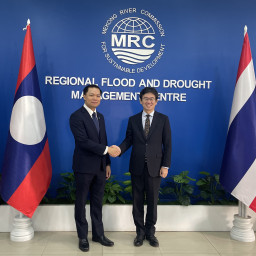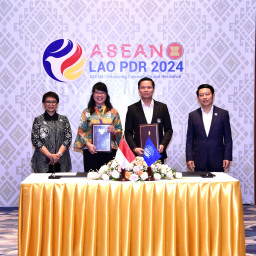Typhoon Doksuri Raises Water Level in the Mekong
The Mekong River Commission monitors the Mekong river daily, including water level, water quality, as well as flood and drought forecasting. Our data affirms that Typhoon Doksuri (Doksuri) is the main contributor to the rising water level in the Lower Mekong Basin (LMB).
This year from April to September, Doksuri marks the nineteenth typhoon making a landfall in the Lower Mekong Basin from 12 to 17 September. Forming in the west of the Philippines, Doksuri moved westward towards Viet Nam (13-15 September) before hitting the Lower Mekong Basin (15 – 18 September) causing heavy rainfall in the upper and middle reaches of the LMB. The highest accumulated rainfall depth sparked by Doksuri was recorded in Chiang Saen (143mm), Nakhon Phanom (152mm) of Thailand, and Thakhek (157mm), Khammouane Province of Lao PDR (See Figure 1).
Figure 1 – Accumulated rainfall in LMB from 11 to 18 September 2017
During the same period, while water level rapidly rose in the upper and middle reaches of the Lower Mekong Basin, none of the stations or locations reached alarm-level. Khong Chiam in Thailand and Pakse of Laos recorded highest increasing water level (See Figure 2).
Figure 2 – Water level in the Lower Mekong Basin from 11 to 18 September 2017
Doksuri has caused Jinghong Dam to release water, but data suggest the discharge has not been the main source to increasing water level in the Lower Mekong Basin, including Chiang Saen.
Jinghong Dam released water at 1,800 cms (6-12 September 2017) and increased to around 2,500cms (14 September 2017). Meanwhile the discharge at Chiang Saen Station was about 4,000cms (5 – 8 September 2017) before increasing to 6,240 cms (15 September 2017). Chiang Saen station measured rainfall of almost 100 millimeters on 12 September 2017 (Figure 3).
The total accumulated water volumes on 5-19 September 2017 at Jinghong (171mcm) and Chiang Saen stations (1,639 mcm), confirms that water volume of more than 1,400 mcm (million cubic meter) was caused by the rainfall in the tributary between Jinghong and Chiang Saen stations.
Figure 3 – Rainfall and discharge at Chiang Saen and Jinghong Dam Discharge on 11-18 September 2017.
-------------------------------------------------------------------
Notes to Editor:
The Mekong River Commission (MRC) is the intergovernmental organisation established to promote cooperation on the sustainable management of the Mekong Basin whose members include Cambodia, Lao PDR, Thailand and Viet Nam. The MRC acts as a platform for water diplomacy and regional cooperation in which member countries share the benefits of common water resources despite different national interests, and address transboundary pressures in the basin. It also serves as a knowledge hub that promotes regional cooperation and policy-making based on scientific evidence.
The MRC provides river-monitoring services, including flood forecasting, to its Member Countries. The MRC created a Flood Management and Mitigation (FMM) strategy in 2001, and in 2005 established the FMM Programme, which ran until 2015. A Drought Management start-up project was established as part of the Information and Knowledge Management Programme in 2010. The MRC Secretariat, headquartered in Vientiane, operates the Flood Management and Mitigation Center in Phnom Penh.
The MRC and China have been exchanging hydrological data during the annual flood season since 2002. The Joint Research on Hydrological Impacts of the Lancang Hydropower Cascade on Downstream Extreme Events is part of the cooperation between the Mekong River Commission and Lancang-Mekong Cooperation Mechanism and exploration of effective collaboration between the China Institute of Water Resources and Hydropower Research, International Water Management Institute, Lancang-Mekong Water Resources Cooperation Center, and Mekong River Commission Secretariat, and Lancang-Mekong countries including Myanmar.





